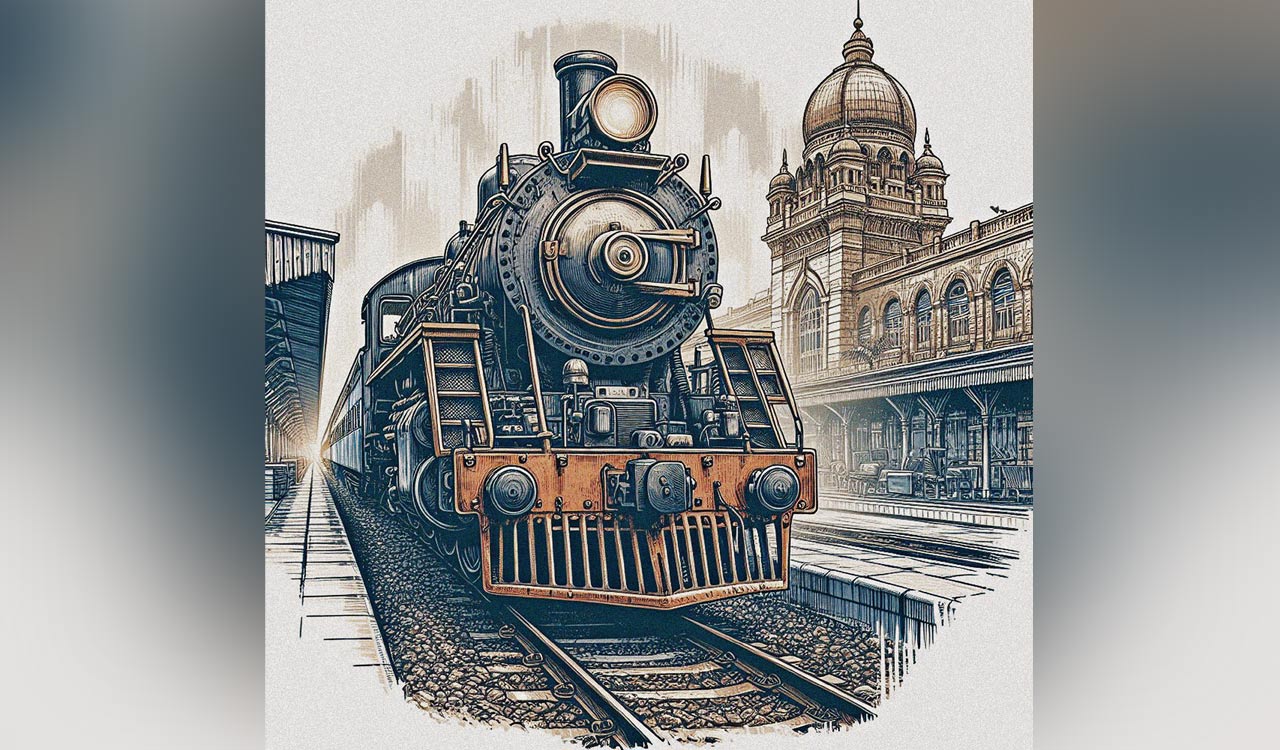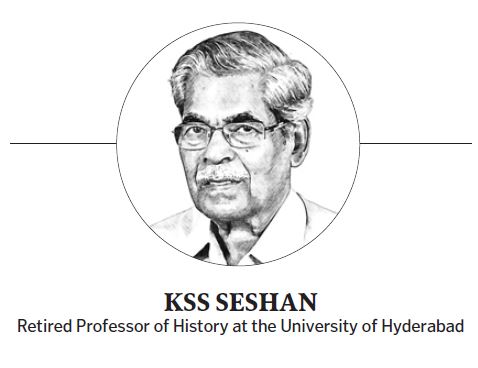It was during Salar Jung’s administration that the British succeeded in pushing through the Railways in Hyderabad, marking the changed phase of Nizam-British relations
Published Date – 13 January 2024, 11:59 PM

By KSS Seshan
For any analysis of the economic critique of British Colonial rule in India, the role of the Railways looms large. There is no exaggeration in the oft-repeated statement that British colonialism did not enter the pores of Indian body politic profoundly until the advent of Railways. What is true of the Indian Railways at the national level was true in the case of Hyderabad as well though the state was under the indirect rule of the British. The introduction of Railways in Hyderabad also marks the changed phase of Nizam-British relations, particularly during Salar Jung’s administration.
Getting on Track
The first-ever Railway line in England was opened in September 1825 between Stockton and Darlington in the coal-rich Durham region in eastern England. Horses were used to haul the coal-laden carriages, particularly from the mines to the plains. However, the rail line with a locomotive, named ‘Rocket’ developed by a school dropout, Stephenson, was opened between Liverpool and Manchester for passengers in 1830. But within a short period of two decades, the British envisaged a firm Railway expansion plan for India, and in 1848, there were rail projects being executed in our country resulting in the first railway line becoming operative between Bori Bandar and Thane in 1853.
In January 1883, Abdul Haq, an official in the service of Salar Jung, prepared a scheme to sell Nizam State Railway to London firm, Morton, Rose & Co, ending the saga of Nizam’s Railway
In his celebrated minutes written in 1853, Lord Dalhousie, the Governor-General, pointed out the important role that India could play as a market for British manufacturers and a supplier of agricultural raw materials once the Railways were developed; the potentialities as a field of investment for British capital and the great use of Railways for rapid mobilisation of troops.
In the case of the advent of Railways in Hyderabad State, the government policies at the national level were extended to the State of Hyderabad as the Nizam was their “faithful ally” and was addressed as “Your Exalted Highness”. As Hyderabad State was strategically located in the centre of the country, no British Railway network could connect both North and South, even East and West, without passing through it.
The British, as a part of their expansion policy of the Railway network in India, approached the Nizam as early as 1850 to lure him to accept the laying of railway lines in Hyderabad State. But the Nizam flatly refused, giving his own reasons. However, after the death of Afzal-ud-Daulah in 1869, the State was run by Sir Salar Jung as the Diwan during whose period all the doors for furthering British interests in Hyderabad were opened in the name of modernity, economic development and ease of transport.
The Beginnings
Hyderabad, besides having the presence of the Subsidiary army, proved to be a potential market and also had within its bounds a rich cotton-growing Berar province. Therefore, the British were anxious to push through the rail network even to the interiors of the State.
On October 2, 1966, the South Central Railway, with Kachiguda as its headquarters, was carved out of Central Railway and the erstwhile Nizam Guaranteed State Railway regions came under its jurisdiction
Sir Bartle Frere, the Governor of Bombay (1862-1867), suggested to Charles Wood, the Secretary of State for India in London, to have the railway line from Bombay to Madras running through Hyderabad State. But this was vehemently opposed by the Governor of Madras, William Denison (1861-1866), who believed that the Nizam was hostile to the British interests and that he may not cooperate with the British in running the railway lines.
Thus, the originally planned Bombay-Madras Railway line did not touch Hyderabad dominion. In 1871, the line up to Raichur was completed by the Great Indian Peninsula Railway. At Raichur, it met the Madras line that came from Gooty. In 1908, the Madras Railway was renamed as ‘Madras South Maratta Railway’ (MSM Railway)
Nizam’s Apprehensions
The Nizam initially did not favour the very idea of having Railways in his dominions. He felt it would upset all orthodox notions and incur the displeasure of his religious-minded subjects. Adding to it, the Nizam believed that the Railways may help his subjects move away from his dominions into the adjoining British-administered regions. He was so apprehensive that he even demanded that in case any member of his family or his servants or their dependents left his territory without his permission using Railways, such absconders should at once be sent back on his request.
Salar Jung keen
Sir Salar Jung (1829-1883), who at the young age of 24 became the Diwan in May 1853 during the reign of Nasir-ud-Daulah, (1829-1857) continued as Diwan to Asaf-ud-Daulah (1857-1869) and Mir Mahboob Ali Pasha (1869-1911) till his death in 1883. Mir Mahaboob Ali Khan, when he was just 3 years old, succeeded to the throne in 1869. It was then that the administration of the State was entrusted to Salar Jung who acted as the Regent during the minority of the young Nizam. Salar Jung thus became the de facto ruler of Hyderabad State during the early phase of Mir Mahaboob Ali Khan’s period. The period 1869 to 1883 can rightfully be called the ‘Age of Salar Jung’ in the administrative history of Hyderabad State.
As Hyderabad State was strategically located in the centre of the country, no British Railway network could connect both North and South, even East and West, without passing through it
It was during Salar Jung’s administration that the British succeeded in pushing through the Railways in Hyderabad. They approached the Nizam’s government with a proposal to build a railway line to Hyderabad by Great Indian Peninsula Railway, a company. It was also stipulated that Hyderabad State was to pay a guaranteed interest to the Great Indian Peninsula Rail. Further arm-twisting by the Governor-General Lord Mayo led to an agreement signed between the British on one side and the Nizam’s government on the other, in May 1870.
The main provisions of the agreement envisaged that the new Railway in Hyderabad would be called Nizam State Railway (NSR) and be the property of the Nizam’s government. The Nizam was to provide land needed for the railway line besides money for construction and its maintenance. The government of India would take responsibility for the construction and maintenance of the railway line through the Resident at Hyderabad. The agreement also specified that the railway line would carry the troops of both Hyderabad and the British in India without hindrance.
Alternative Routes
Though Gulbarga was a major town with thriving trade, it was ignored and the Wadi station on the Great Indian Peninsula Railway line was chosen from where the Nizam State Railway took off for Hyderabad. In fact, the line did not pass through any of the towns where brisk trade took place but through Tandur-Vikarabad, the rocky stretch and forest tracts. It was, therefore, evident that the primary aim of the British in laying the line was for military purposes.
The Wadi-Secunderabad section, the first-ever railway line in Hyderabad dominion with a length of 192 km, was opened with great fanfare on 8 October 1874
The British Resident at Hyderabad, George Yule, as early as 1863 prepared a detailed note assessing the relative merits of two alternative routes, which could be taken up for connecting Madras and Bombay. He favoured a route via Gulbarga and Hyderabad in preference to a shorter route via Mudgal and Bellary. There was also an intermediary route which passed from Gulbarga to Raichur, meeting the original line at Gooty. This route was finally accepted and a branch line was later built from Gulbarga to Hyderabad.
Reasons for Rail Line
Interestingly, George Yule cited several reasons to bring Hyderabad onto the railway map in India. He felt that the railway Line through Hyderabad would make the troops at Secunderabad available at short notice for both Madras and Bombay, whereas a direct line bypassing Hyderabad would deprive not only these two places but even their cantonments like Bangalore and Poona. Another derogative reason he gave in favour of Railways in Hyderabad was that Hyderabad according to him was a “corpse”, and went on to describe that the Nizam and his nobles, with the exception of Salar Jung the Prime Minister, “had no life in them.” He felt that the Railways would give the much-needed money, energy and hope to the lower classes. “The rise of such lower classes from their debased condition may result in some ideas of an enlightened policy which the government may be forced to follow”.
First Railway Line
The survey of the Wadi-Secunderabad section began in late 1869 and the construction started by March 1871 under the supervision of Major Meade, who earlier served the Bengal Staff Corps. The Wadi-Secunderabad section, the first-ever railway line in Hyderabad dominion with a length of 192 km, was opened with great fanfare on 8 October 1874. Besides Salar Jung, members of the Royal family and select officers were present at the inaugural function in Hyderabad.
The line did not pass through any of the towns where brisk trade took place but through Tandur-Vikarabad, the rocky stretch and forest tracts, making it evident that the primary aim of the British in laying the line was for military purposes
Two days later, the Resident personally met and obtained formal acceptance from the 9-year-old boy — Nizam Mir Mahboob Ali Khan. The next line to be taken up was the Secunderabad- Warangal section with a length of 140 km and was opened on April 8, 1886. Metre-gauge lines were also laid from Manmad to Secunderabad connecting Aurangabad, Jalna, Nanded and Nizamabad between 1889 and 1900.
Loan from London
The deteriorating financial situation of Nizam’s government made Salar Jung enter into negotiations with a London firm, Smith Flemcy & Co, for raising funds in the London money market. In March 1874, the company wrote to the Secretary of State for India for advancing capital for a railway line covering 204 miles (around 328 km) from Hyderabad to Warangal and from there to Singareni and further to river Godavari, close to Bhadrachalam.
The objective of this railway line was to carry coal from Singareni to the Great Indian Peninsula Railway system via Hyderabad and Gulbarga, to give free access to the heart of Deccan to imports as well as rice from the coastal districts and to stimulate the production of exportable articles in the districts through which the railway lines ran. Salar Jung’s efforts to raise money for the Nizam’s State was mainly to create a lobby in London by making contacts with influential people to obtain the restoration of Berar which hitherto was ceded to the British. After an inordinate delay, in June 1875, Salar Jung was successful in getting a loan from the London Stock Exchange.
In January 1883, Abdul Haq, an enterprising official in the service of Salar Jung, prepared a scheme to sell Nizam State Railway for 12 lakh pound sterling to Morton, Rose & Co, which was a joint stock company in London. Thus ended the saga of Nizam State Railway. The British company renamed it Nizam’s Guaranteed State Railway. Incidentally, Salar Jung died a few months before such an agreement took place (8 Feb 1883) and thus did not live to see the popular agitation in Hyderabad State against this takeover and the proposed new railway line to Chanda, a border town of Hyderabad State.
Enigmatic MD
Any account of Nizam State Railway would never be complete without making a reference to the role of Cyril Walter Jones (1881-1981), the Managing Director. Cyril Jones joined Nizam State Railway in 1904 as an Assistant Engineer and was associated with it for more than three decades. Having worked as a railway engineer, his memoirs give us a detailed account of the development and growth of the Railways in the erstwhile Hyderabad State and contribute substantially to the sparse historical material on the subject. Jones, however, does not restrict himself to a mere narration of his official domain. He throws a good deal of light on the social life, customs and manners of people and the nobility of Hyderabad during the period of his stay here.
Hyderabad, besides having the presence of the Subsidiary army, proved to be a potential market and also had within its bounds a rich cotton-growing Berar province which the British were anxious to exploit through the rail network
Nizam’s Guaranteed State Railway continued to run all the broad-gauge and metre-gauge lines up to March 1930. After that, the Railways were reverted to the Hyderabad State. However, the headquarters of the Nizam Railway remained in London. After World War II broke out in November 1941, the HH Nizam Railway Board was shifted from London to Hyderabad. On 5 November 1951, Great Indian Peninsula Railway and Nizam State Railway, along with a few others like Scindia State Railway and Dholpur Railway, merged to form the Central Railway. At the time of merger, the Nizam State Railway system, with 2,351 km in length, was the largest system run by any Indian princely State.
On October 2, 1966, the South Central Railway, with Kachiguda as its headquarters, was carved out of the Central Railway and the erstwhile Nizam’s Guaranteed State Railway regions came under its jurisdiction. This is where it stands today.
An interesting aspect of Nizam State Railway was that it comprised the entire gamut of transport systems like rail, road and air services.





